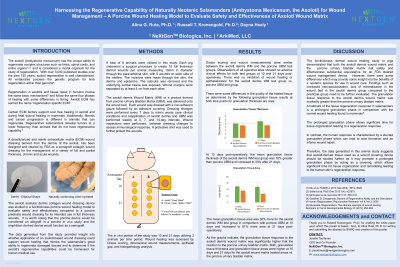Laboratory Research
(LR-019) Harnessing the Regenerative Capability of Naturally Neotenic 1 Salamanders (Ambystoma Mexicanum, the Axolotl) for Wound Management – A Porcine Wound Healing Model to Evaluate Safety and Effectiveness of Axolotl Wound Matrix

The axolotl has the unique ability to regenerate limbs, tails, and organs1,2,3. A decellularized and sterile extracellular matrix (ECM) wound dressing derived from axolotl dermis, has been designed and cleared by FDA as a xenograft collagen wound dressing for management of a variety of full and partial thickness, chronic and acute wounds. This product was evaluated in a full-thickness porcine wound healing model to evaluate safety and effectiveness. Axolotl tissue was used to determine if its regenerative capabilities could be harnessed for human medical use.
Methods:
Each pig surgically received full thickness dermal 10 mm diameter wounds through the paravertebral skin, with 5 wounds on each side of the midline. The axolotl dermis Wound Matrix (WM) or a product derived from porcine Urinary Bladder Matrix (UBM), was delivered onto the wound site. The in vivo portion of the study was 10 and 21 days. Wound healing was assessed by Draize scoring, wound closure measurements, and histopathology analysis.
Results:
Draize scoring and wound measurements were similar between the axolotl dermis WM and the porcine UBM test groups. No adverse clinical effects at all operative sites for both test groups at 10 and 21 days post-operatively. No inhibition of wound healing or epithelialization for the axolotl dermis WM test group vs. porcine UBM.
At 10 days post-operatively, the mean granulation tissue thickness of the axolotl dermis WM test group was 16% greater than porcine UBM and increased to 33% after 21 days. The mean granulation tissue area was 36% more for the axolotl dermis WM test group in comparison with porcine UBM at 10 days and increased to 81% more area at 21 days post-operatively.
Discussion:
Both axolotl dermis WM and porcine UBM met safety and effectiveness substantial equivalence for an FDA cleared wound management device. The granulation tissue response to the axolotl-derived WM was markedly greater than porcine UBM. The data suggests that axolotl-derived tissue used as a wound management device should be studied further as it may promote a prolonged granulation phase which allows significant time for tissue organization leading to a regeneration response such as in salamanders.
Trademarked Items:
References: (1) Mu et al, FASEB J. 2014 Sep 28(9): 3919–3929.
(2) Seifert et al, PloS One 2012 7(4): e32875.
(3) McCusker et al, Gerontol 2011 57: 565=571.

.png)